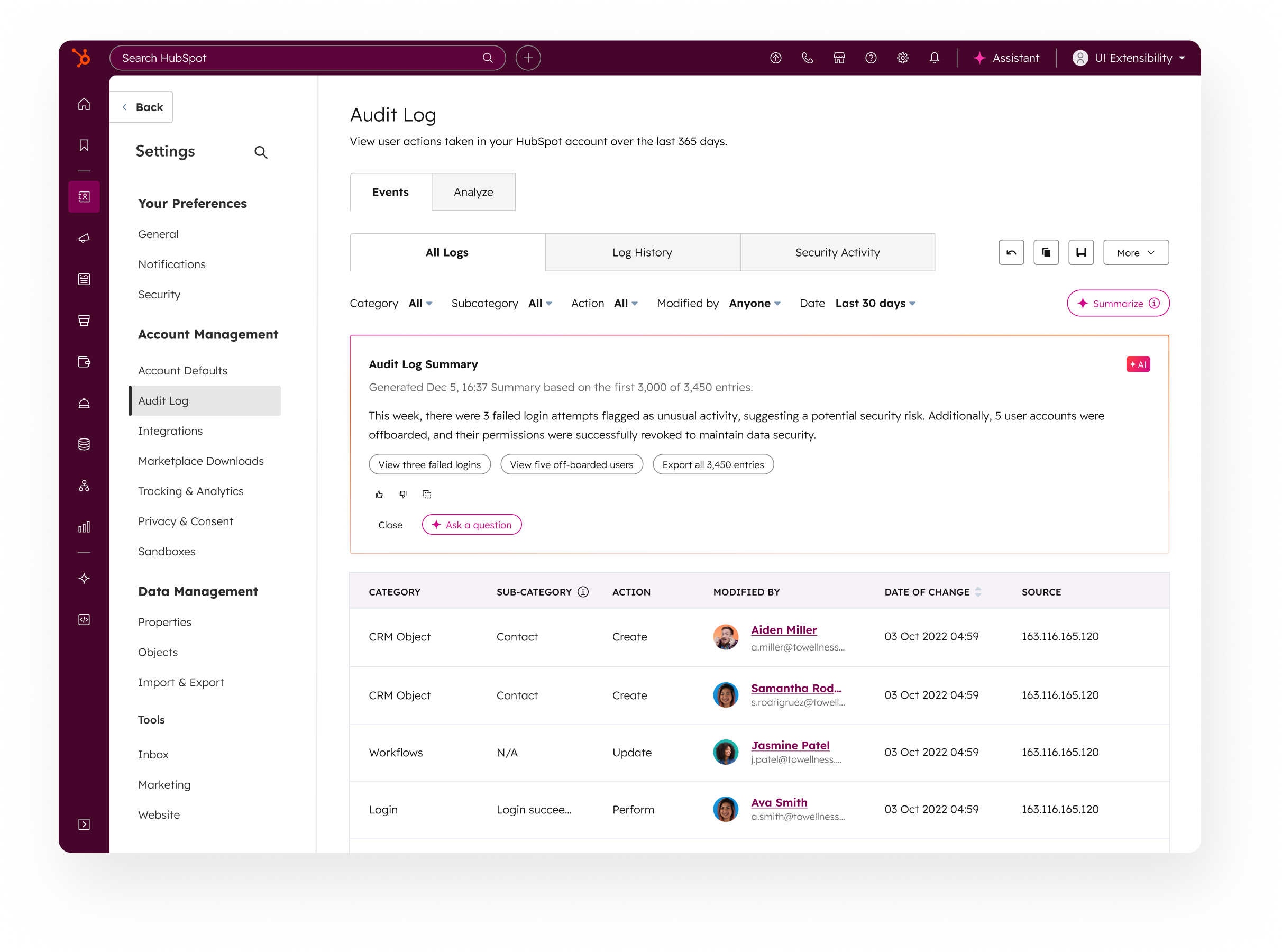
My Role
Lead Product Designer
Timeline
2 weeks (July 2025)
Overview
I designed an AI-powered summarization feature that turned dense audit logs into clear, human-readable insights. It helped admins quickly understand key activities and spot unusual changes, and achieved a 23% engagement rate, above the 19% average for all AI Summaries at HubSpot.
HubSpot admins handle security and troubleshooting. When issues arise, they spend hours combing through thousands of log entries — a “needle in a haystack” process that slows response time and reduces confidence in system reliability.
Our challenge: How could we reduce an admin's time-to-insight and increase their confidence in account security, without adding more complexity to their workflow?

The Design Strategy: Building Trust in an AI Summary
Principle 1 : Proactive Communication
The summary clearly surfaced what it could and could not explain, helping admins set realistic expectations.
Principle 2: Data-Informed Confidence
Coverage indicators visualized how much of the activity the AI captured at different confidence levels, helping users gauge reliability at a glance.
Principle 3: Transparent Feedback
Contextual warnings appeared when the AI encountered uncertain or missing data, building trust through honest communication instead of overpromising results.
1. Proactive Constraints
I added an info icon to the "Generate" button, which proactively explains the feature's scope (e.g., "Summarizes the last 7 days, up to 3,000 entries"). This manages expectations from the start.
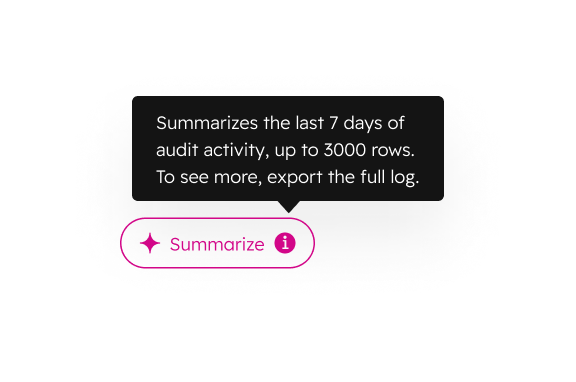
2. Data-Informed Trade-offs
I worked with engineering to analyze user activity. The data showed a massive skew: while the top 1% (P99) of users generated ~3,000 events/week, the top 0.1% (P99.9) generated over 28,000. We made a strategic decision to set our limit at 3,000. This allowed us to perfectly serve 99% of our customers while pragmatically scoping out the extreme 0.1% outliers, which would have required 10x the engineering cost for a tiny user segment.

3. An Actionable & Transparent Result:
I designed the widget to be more than just a summary; it's an action hub.
It turns insights into action: The AI identifies key findings (like "3 failed logins") and generates dynamic, contextual buttons (View 3 failed logins) that deep-link the user directly to those filtered events.
It provides a trust-building "escape hatch": For the 1% of users who exceed the 3,000-entry limit, the UI provides a clear note ("Summary based on the first 3,000 of 3,450 entries") and a prominent "Export all 3,450 entries" button, turning a moment of failure into one of guided action.
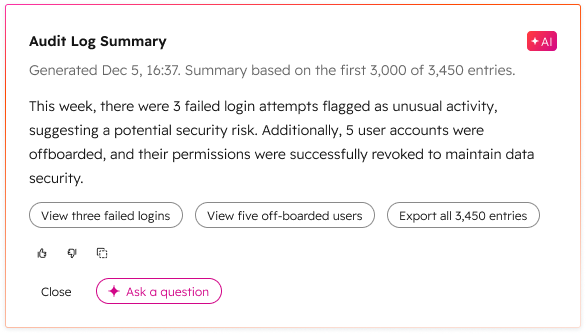
This approach helped admins stay informed without interrupting their workflow — trust through transparency, not surprise.
Exploration: Widget vs. Copilot
I explored two primary strategies for displaying the AI summary. The first was a widget and the second was a Copilot side panel.. I evaluated them against 3 key selection criteria.
.png)
The widget was the clear winner. It solved the user's need perfectly while being 100% feasible to ship immediately. The widget offered a lightweight, embedded experience aligned with HubSpot’s design system, while the copilot required deeper context-switching.
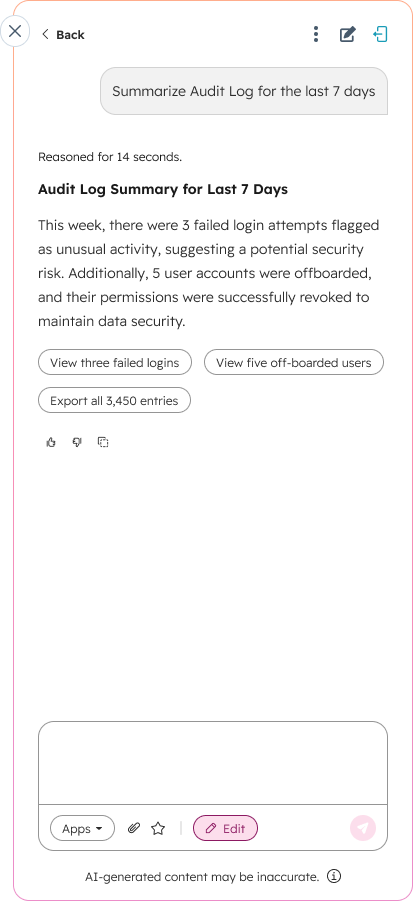
Key Interaction: Progressive Disclosure
We hypothesized that not every admin would need this summary on every visit. To reduce initial cognitive load and save valuable vertical space, I opted against showing the summary by default.
I chose a "Summarize" button as a progressive disclosure mechanism. This approach respects the user's attention and gave us a clear, non-intrusive way to measure feature adoption and value via click-through data.
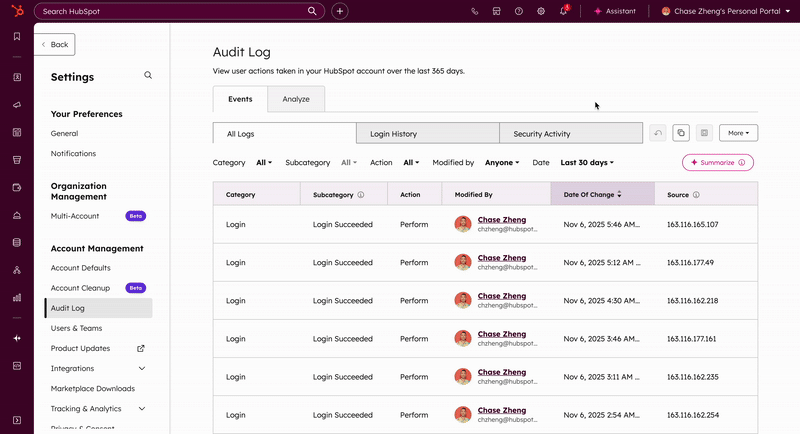
Outcome
To test our hypothesis and deliver value quickly, we launched a streamlined MVP to all Pro+ HubSpot admins. The feature's adoption was a success, hitting a 23% engagement rate—higher than the 19% average for new features on the platform.
This quantitative win, combined with powerful qualitative feedback, proved the value of our trust-first design. The success of the MVP validated our "north star" vision, which is represented by the polished designs throughout this case study.
"..this summary saved me 20 minutes of scrolling through the log on the first day using it ...." - Jennifer, marketing ops of a retail company
Key Takeaways:
• Designed for trust by proactively communicating uncertainty and visualizing the limits of AI insight
• Used data to inform tradeoffs between coverage and confidence, creating a balanced, transparent experience
• Designed contextual cues and info buttons that helped admins understand when to trust the AI’s summary and when to verify manually
This project taught me how to design for trust in AI, balancing automation with transparency and giving users confidence without hiding complexity. The design established a foundation for future AI-driven features within HubSpot’s Audit Log experience.
